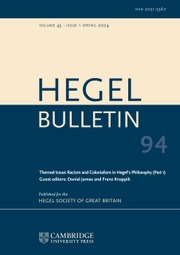No CrossRef data available.
Article contents
Beauties of Nature and Beauties of Art: On Kant and Hegel's Aesthetics
Published online by Cambridge University Press: 23 June 2015
Abstract
This paper is an attempt to sketch the general framework of Kant and Hegel's Aesthetics, which are dealt respectively in sections I and II.
The first section considers Kant's stated aims in the introduction to the Critique of Judgment, his location of judgments of taste within the problematic of reflective judgment, his treatment of reflective aesthetic judgments in the analytic of the beautiful and the distinction between objective reality and subjective universal validity. The second section provides a sketch of Hegel's division of artistic beauty into symbolic, classical and romantic art in the attempt to explain how Hegel's restriction of the subject matter of aesthetics to fine art, may shed light on his critique of Kantian ‘subjectivism’.
Kant's discussion of aesthetics is located within the problematic of reflective judgment in general, that is, within a discussion of the suitability of nature for cognition. Reflective judgments are first contrasted with determinant judgments and then divided into two kinds, aesthetic and teleological. The distinction between aesthetic and teleological reflection, captures the distinction between a kind of pleasure which arises from the conformity or harmony of imagination and the understanding, and a kind of pleasure which arises from the conformity or harmony of the understanding with reason. The fact that pleasure arises in reflective judgments in general, and is not an exclusive feature of aesthetic reflection, is not transparent from Kant's introduction, but is suggested by the claim that although the acknowledgment that the various empirical laws of nature are amenable to systematic categorization, no longer gives rise to pleasure, this is simply due to the fact that the repeated experience of the systematic unity of empirical laws, is no longer an occasion for surprise:
It is true that we no longer notice any decided pleasure in the comprehensibility of nature, or in the unity of its divisions into genera and species, without which the empirical concepts, that afford us our knowledge of nature in its particular laws, would not be possible. Still it is certain that the pleasure appeared in due course, and only by reason of the most ordinary experience being impossible without it, has it become gradually fused with simple cognition, and no longer arrests particular attention.
- Type
- Hegel and Kant
- Information
- Bulletin of the Hegel Society of Great Britain , Volume 17 , Issue 1: number 33 , Spring/Summer 1996 , pp. 70 - 86
- Copyright
- Copyright © The Hegel Society of Great Britain 1996
References
1 Kant, , Critique of Judgment, Oxford Clarendon Press, 1988, p 28 Google Scholar.
2 Kant, , Critique of Judgment, §22 p 85–86 Google Scholar.
3 Kant, , Critique of Judgment, §22 p 86 Google Scholar.
4 Kant, , Critique of Judgment, §10 p 61 Google Scholar.
5 Kant, , Critique of Judgment, §2 p 43 Google Scholar.
6 Kant, , Critique of Pure Reason, B149 Google Scholar.
7 Kant, , Critique of Judgment, §21 p 83 Google Scholar.
8 Kant, , Critique of Judgment, §39 p 150 Google Scholar.
9 Shaper, Eva, “Taste, Sublimity and Genius: the aesthetics of nature and art” in The Cambridge Companion to Kant, Cambridge University Press 1992, p 378 Google Scholar.
10 Kant, , Critique of Judgement, §38, p 147 Google Scholar.
11 Hegel, , Lectures on Fine Art, in Aesthetics, Hegel's, translated by Knox, T M, Oxford Clarendon Press, Vol I, p 7 Google Scholar.
12 Hegel, , Lectures on Fine Art, p 57 Google Scholar.
13 Hegel, , Lectures on Fine Art, p 30–31 Google Scholar.
14 Hegel, , Lectures on Fine Art, p 153–54Google Scholar.
15 Hegel, , Lectures on Fine Art, p 306 Google Scholar.
16 Hegel, , Lectures on Fine Art, p 309 Google Scholar.
17 Hegel, , Lectures on Fine Art, p 351 Google Scholar.
18 Hegel, , Lectures on Fine Art, p 351 Google Scholar.
19 Hegel, , Lectures on Fine Art, p 316 Google Scholar.
20 Hegel, , Lectures on the Philosophy of World History, translated by Nisbet, H B, Cambridge University Press, 1975, p 134 CrossRefGoogle Scholar.
21 Hegel, , Lectures on Fine Art, p 476 Google Scholar.
22 Hegel, , Lectures on Fine Art, p 479 Google Scholar.
23 Hegel, , Lectures on Fine Art, p 500 Google Scholar.
24 Hegel, , Lectures on Fine Art, p 494 Google Scholar.
25 Hegel, , Lectures on Fine Art, p 472 Google Scholar.
26 Hegel, , Lectures on Fine Art, p 474 Google Scholar.
27 Hegel, , Lectures on Fine Art, p 317 Google Scholar.
28 Hegel, , Lectures on Fine Art, p 489 Google Scholar.
29 Hegel, , Lectures on Fine Art, p 518 Google Scholar.
30 Hegel, , Lectures on Fine Art, p 522 Google Scholar.
31 Hegel, , Lectures on Fine Art, p 523 Google Scholar.
32 Hegel, , Lectures on Fine Art, p 538 Google Scholar.
33 Hegel, , Lectures on Fine Art, p 531 Google Scholar.
34 Hegel, , Lectures on Fine Art, p 487 Google Scholar.
35 Hegel, Encyclopaedia Logic, §171.
36 Hegel, , Lectures on Fine Art, p 164 Google Scholar.
37 Hegel, Encyclopaedia, §459.
38 Hegel, Encyclopaedia, §462.
39 Hegel, Encyclopaedia, §88.


